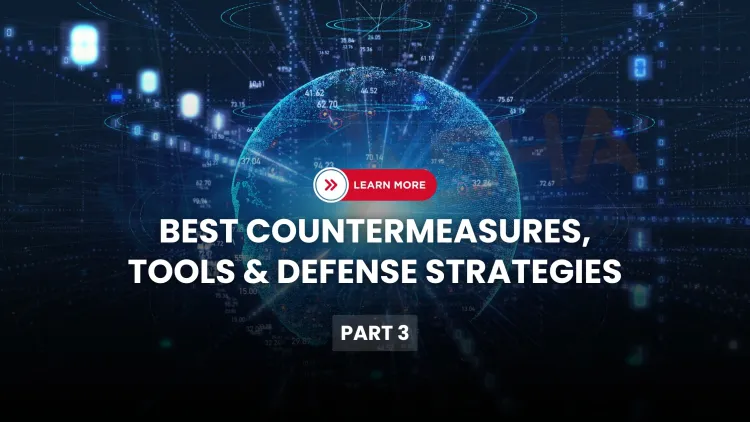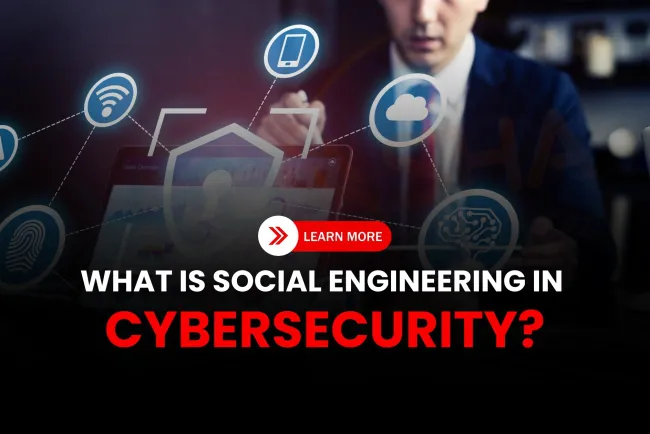Social Engineering – Part 3 | What Are the Best Social Engineering Countermeasures? Tools, Techniques, and Strategies Explained
Social engineering attacks are one of the most dangerous forms of cyber threats because they target human behavior instead of system flaws. In this third part of our blog series, we dive deep into the best countermeasures against social engineering. From technical tools like phishing filters and MFA to human-centered training and physical access controls, this guide covers everything you need to prevent manipulation and deception. Learn how companies and individuals can protect themselves with awareness programs, simulated phishing, policy enforcement, and cutting-edge cybersecurity solutions.

Table of Contents
- Why Countering Social Engineering is Crucial
- What Are Social Engineering Countermeasures?
- Technical Countermeasures
- Human-Based Countermeasures
- Physical and Procedural Countermeasures
- Popular Tools for Defense
- Real-World Case Study: Stopping a Phishing Attack
- Conclusion
- Frequently Asked Questions (FAQs)
Why Countering Social Engineering is Crucial
Social engineering attacks are dangerous because they exploit human trust instead of relying solely on technical vulnerabilities. Whether it’s phishing, smishing, baiting, or impersonation, attackers use clever tricks to make you take risky actions. In this part of our series, we’ll explore the best ways to defend yourself and your organization from these manipulative threats.
What Are Social Engineering Countermeasures?
Social engineering countermeasures are tools, techniques, and habits that help detect, prevent, and respond to human-based cyber attacks. These defenses fall into three main categories:
| Category | Description |
|---|---|
| Technical Controls | Security systems and tools that detect or block suspicious activities |
| Human/Organizational Measures | Policies, training, and awareness programs for people |
| Physical and Process Defenses | Surveillance, access controls, and documented procedures |
1. Technical Countermeasures
Email Filtering and Phishing Detection Tools
Use spam filters and phishing detection services like:
-
Microsoft Defender for Office 365
-
Proofpoint
-
Barracuda Email Security
-
Gmail Advanced Protection
These tools scan links, attachments, and sender info to detect suspicious messages.
Multi-Factor Authentication (MFA)
MFA adds an extra layer of protection by requiring you to confirm your identity with a second factor (like a code or fingerprint), making it harder for attackers to break in—even if they have your password.
Endpoint Detection and Response (EDR)
EDR tools like CrowdStrike, SentinelOne, or Sophos Intercept X monitor devices for unusual behavior, such as strange app installations or communication with known malicious IPs.
Browser Isolation and DNS Filtering
Prevent risky websites from opening or executing scripts by using solutions like:
-
Menlo Security (browser isolation)
-
Cisco Umbrella or Cloudflare Gateway (DNS filtering)
2. Human-Based Countermeasures
Security Awareness Training
Educate employees with regular, interactive training that teaches them:
-
How phishing and smishing attacks work
-
How to spot red flags (misspellings, fake URLs, urgency)
-
What to do if they suspect an attack
Tools for training include:
-
KnowBe4
-
Cofense
-
Curricula
Phishing Simulations
Run mock phishing campaigns to test employee readiness and help them learn from mistakes.
Zero Trust Mindset
Teach users not to trust emails, links, or attachments—even if they appear to come from coworkers—unless verified through a second channel.
3. Physical and Procedural Countermeasures
Access Control
-
Use ID cards, biometric scanners, or keypad locks to limit who can physically enter office buildings or server rooms.
-
Implement visitor logs and surveillance cameras for high-security areas.
Policy Enforcement
Ensure there are clear rules like:
-
Never share passwords over email or phone
-
Always confirm identity via official channels before sharing sensitive information
-
Report any suspicious activity immediately
Incident Response Playbooks
Have a response plan in place for suspected social engineering attacks. It should include:
-
How to isolate the device or account
-
Who to notify (IT, management)
-
What evidence to collect (email headers, screenshots)
-
Recovery steps (password resets, malware scans)
Popular Tools for Defense
| Tool | Purpose |
|---|---|
| KnowBe4 | Security awareness training |
| GoPhish | Open-source phishing simulation |
| Microsoft Defender | Email and endpoint protection |
| CrowdStrike Falcon | EDR and real-time threat response |
| Cisco Umbrella | DNS filtering and policy enforcement |
| Zscaler Internet Access | Secure web gateway |
Real-World Case Study: Stopping a Phishing Attack
In early 2025, a finance firm stopped a credential theft attack thanks to a simulated phishing program. A new employee received a fake Microsoft login page via email but recognized the trick because of training. She reported it to IT, who discovered and blocked the attacker’s IP address before damage occurred. Proactive awareness saved the organization.
Conclusion
Defending against social engineering is not just about firewalls and software—it’s about building a security-first culture. When employees are trained and systems are hardened, attackers lose their biggest advantage: human error.
The best strategy is to combine technology, training, and policies. Stay alert. Stay secure.
FAQs
What is a social engineering countermeasure?
A social engineering countermeasure is a tool, technique, or policy designed to prevent, detect, or respond to cyber attacks that rely on human manipulation.
Why is social engineering dangerous?
It tricks people into revealing sensitive information or performing risky actions, often bypassing technical security systems.
How can companies prevent phishing attacks?
By using email filters, employee training, phishing simulations, and multi-factor authentication (MFA).
What tools help stop phishing emails?
Popular tools include Microsoft Defender, Proofpoint, Barracuda, and Gmail's Advanced Protection.
What is phishing simulation training?
It's a mock phishing campaign used to test and train employees to recognize and avoid real phishing attempts.
What is KnowBe4 used for?
KnowBe4 is a platform for security awareness training and phishing simulation.
Can antivirus stop social engineering attacks?
Not always, since social engineering targets people, not just systems. Antivirus helps, but training is essential.
What is TOAD in cybersecurity?
TOAD stands for Telephone-Oriented Attack Delivery, a type of phishing where victims are tricked into calling attackers.
How does multi-factor authentication (MFA) help?
It adds an extra verification layer, preventing unauthorized access even if passwords are stolen.
What is DNS filtering?
It blocks access to dangerous websites by filtering malicious domains at the network level.
How does browser isolation improve security?
It runs web pages in a separate environment, protecting users from harmful scripts and exploits.
What is the role of security awareness training?
It educates users to recognize and respond to social engineering tactics like phishing or baiting.
What’s the best phishing simulation tool?
GoPhish is a great open-source option, while KnowBe4 and Cofense offer enterprise-level solutions.
Why are simulated attacks important?
They prepare users for real threats and highlight vulnerabilities in human behavior.
What is a human firewall?
A trained and security-aware employee who can spot and resist social engineering attacks.
How often should companies run phishing tests?
Every 30 to 90 days is recommended for maintaining awareness and improving behavior.
What is endpoint detection and response (EDR)?
EDR monitors endpoints for suspicious activity and responds in real-time to threats.
How can companies secure their buildings?
By using physical security measures like biometric locks, ID badges, and visitor logs.
What is access control in cybersecurity?
It limits who can access what resources, reducing the chance of insider or social engineering attacks.
Can AI help detect social engineering?
Yes, AI-powered email filters and behavior analytics can identify unusual activities.
What’s the difference between phishing and smishing?
Phishing uses email, while smishing uses SMS to trick victims into sharing information.
Is social engineering always digital?
No, it can happen physically (e.g., tailgating) or over the phone (e.g., vishing).
What should employees do if they suspect a phishing email?
Report it to the IT/security team immediately and avoid clicking any links or downloading attachments.
What policies help prevent social engineering?
Strong password policies, mandatory MFA, and employee training policies.
How do cybercriminals exploit trust?
By impersonating known brands, colleagues, or tech support to trick victims.
What is the role of an incident response team?
To investigate, contain, and resolve security breaches quickly and effectively.
Why are VoIP numbers used in TOAD attacks?
They’re cheap, easy to set up, and hard to trace—perfect for scammers.
What should a good awareness program include?
Real-world examples, interactive training, regular updates, and simulated attacks.
Can small businesses afford social engineering defense tools?
Yes, many open-source tools and affordable training platforms are available.
What’s the future of social engineering protection?
More automation, AI-powered detection, and integrated human-technology defense systems.














![Top 10 Ethical Hackers in the World [2025]](https://www.webasha.com/blog/uploads/images/202408/image_100x75_66c2f983c207b.webp)








